| |
There are many things a chestnut tree will tell you if you know how to listen.
Chestnut trees talk in simple terms like, "I am hungry", "I am thirsty", and
"I am not feeling so well". With chestnut trees we do not have "Read my lips",
but "Read my leaves" and reading a leaf is what we will do.
Part of the training an Emergency Medical Technician receives is how to
determine if a patient is "Sick or not sick" from just a quick look. Chestnut
trees can also be treated in the same way from just a few feet away determine
"Sick or not sick". The good news is a chestnut tree's sudden death is defined
in weeks or months not minutes or hours. So by just walking by a chestnut tree
and taking a quick look at the leaves we will be able to determine "Sick or
not sick".
Chestnut trees tell us a lot of how they are feeling by their leaves and their
bark. Usually, when there is a serious problem with a chestnut tree the leaves
will show the first signs. As the problem gets worse, the bark on the tree
will have signs telling us "I am feeling real bad, like I might die". If the
bark is showing signs then it may be too late to do much to save the tree. We
will take a look at both healthy trees and sick trees. Ever have someone say
to you, "You are not looking so good, are you feeling sick?" Well, with
chestnut trees, looking good is having vigor and good looking leaves. Generally
speaking, a sick chestnut tree will not produce nuts. If your chestnut tree
isn't producing nuts with kernels, then it might be stressed by the growing
conditions.
So let's start with what to look for in a healthy chestnut tree. During the
growing season we have both leaves and bark to examine. While dormant, only
bark is present for examination and can only help us determine if the chestnut
tree is very sick or dead. The picture below is of a Bisalta #3 chestnut tree
at bloom time (mid July). This tree is saying "I am healthy, full of energy,
and look at me grow". These traits can be visually observed in the quality and
size of the male flowers (catkins), the size, color, shape of the leaves. The
terminal growth, that is the new growth at the end of the branches, is more
than 12 inches. Not all chestnut tree cultivars look like this so the
evaluation of health should be compared with a like chestnut cultivar.
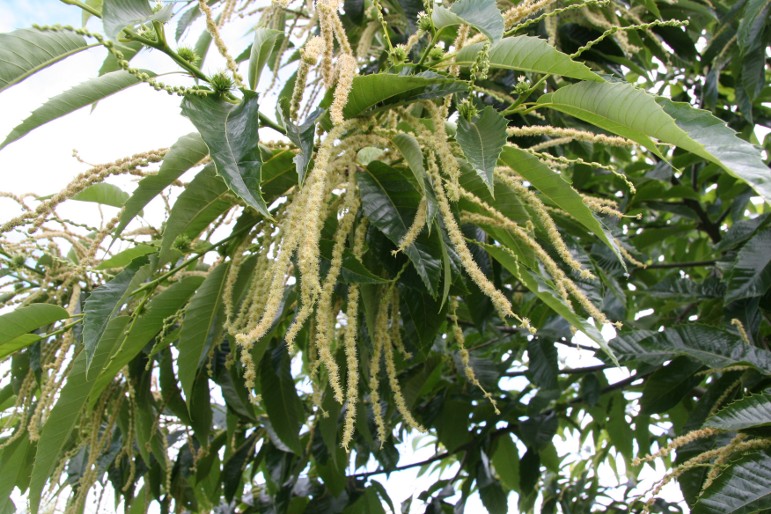
Notice the bottom of the leaf is a lighter color than the top of the leaf. The
amount of difference in color varies between chestnut cultivars. On some
cultivars, like this one, the color difference is slight but noticable. The
next picture is of a Colossal chestnut tree. Notice the bottom of the leaf is
much lighter in color than the top.
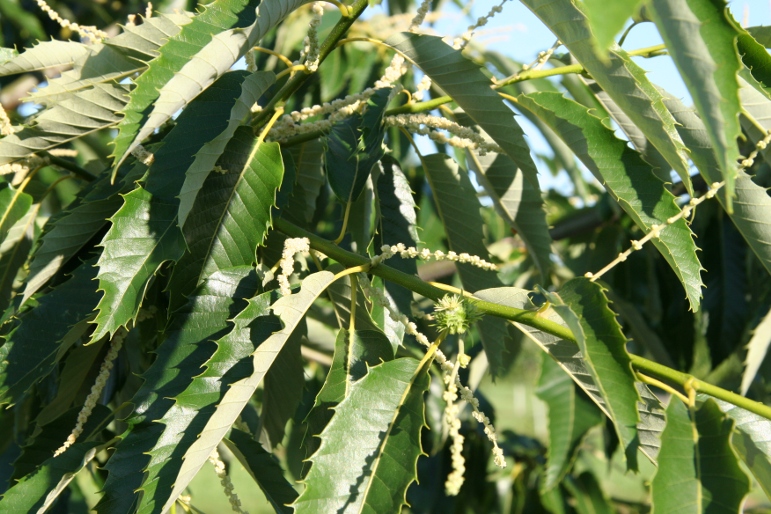
Also, take a good look at the amount of leaf curl. The Colossal chestnut leaf
curls when the summer sun is intense. Other chestnut cultivars do the same
leaf curl, but usually not as much as the Colossal does. In other plants when
the leaf curls like this, it is a possible indication of water stress, not so
with chestnut trees. When the leaf curls like in these pictures it is normal
and healthy.
If we kind of just look at an overall perspective of these top two photos, we
see leaves that are complete without munch marks or holes in them, the color
is a consistant color across the entire leaf and each leaf on the branch looks
just about the same as all the others. These are examples of what you would
look for when checking the health of your chestnut trees. Next, we will look
at photos of chestnut trees that do have health issues.
One of the most common condition found in chestnut orchards is nitrogen
deficiency. The problem with just looking at the chestnut leaf is that some
other conditions can look just about the same. Here is some examples. The
picture below is of a Colossal chestnut tree deficient in nitrogen. Notice the
yellowing at the ends of the smaller leafs. Difficult to notice in this photo
but the size of the leafs are about 60 percent of what a healthy Colossal leaf
would be.
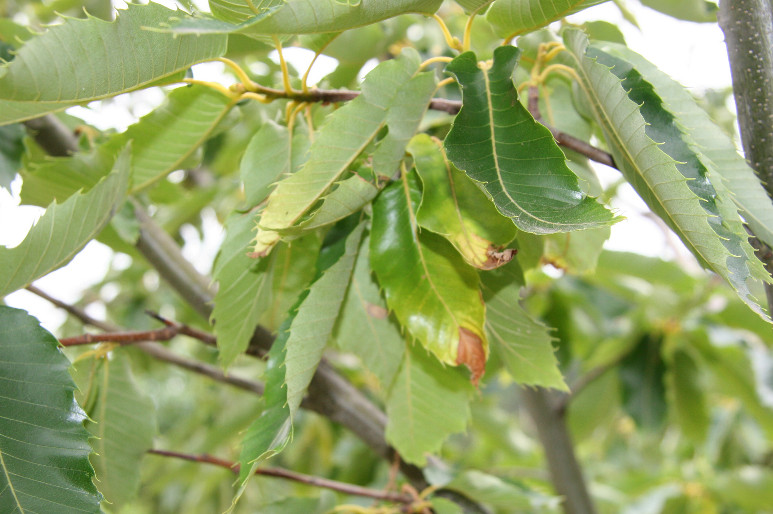
This next picture shows a chestnut tree with boron damage. The orchardist
applied a foliar spray of boron to the chestnut tree. The application exceeded
what the chestnut tree could handle. The resulting damage looks like what this
next picture illustrates. If you apply boron as a foliar spray then you may
end of with your chestnut leafs looking like this:
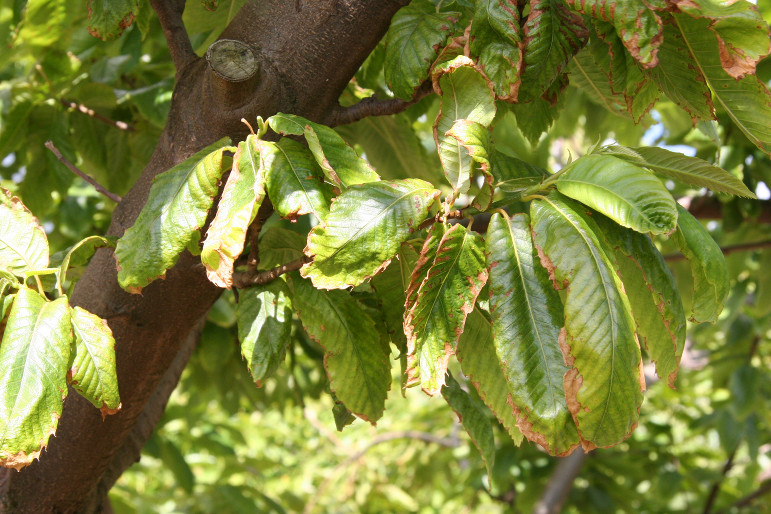
In both the picutres of the nitrogen deficency and excessive boron the leaf
edges have yellowing and even some browning. In a way it could be difficult to
tell the difference if you did not know the history of what the chestnut tree
was exposed to. This next picture is of a chestnut tree that is on its death
bed. The tree has root problems that are showing up in the leaves. Since the
roots are breaking down, the small leaves appear to be doing ok, but the the
large leaves are brown over 50% of the leaf area. About 3 weeks after this
photograph was taken the tree was dead. The culprit, in this case it was
phytophthora, also known as root rot.
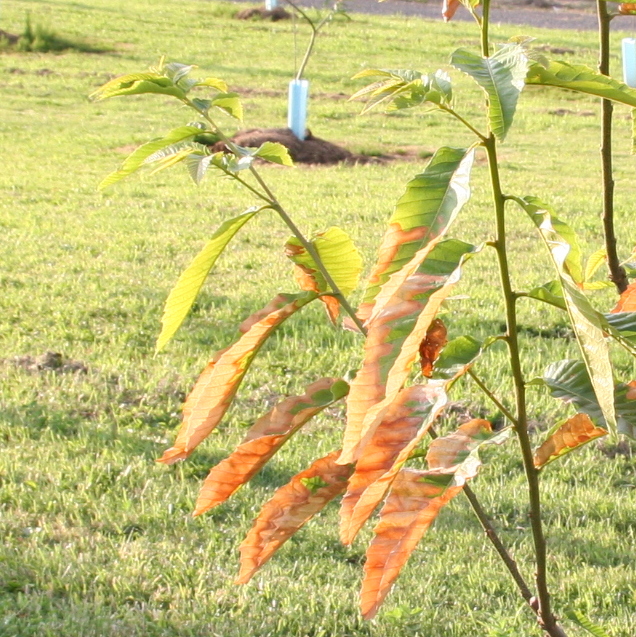
Next we turn our attention to the base of the chestnut tree where we find the
graft on a grafted chestnut tree. Almost all plants that are propagated using
grafting of a root stock and the scion wood have the potential of graft union
failure. Graft union failure can show up on chestnut trees many years after
the graft was formed. A failure at the graft union can have a number of
different indicators such as top die back and underperforming growth observable
in undersized or deformed leaves.
The picture also shows that its just not the leaves we need to be observing,
we also need to be looking over the entire stucture of the tree such as the
branches, the trunk, and the bark. The bark above the graft is one color and
below the graft it is a different color. Aside from the bark color having
differences, the size of the trunk is different sizes above and below the
graft. As you can see, being able to recognize potential problems starts with
coming to know what a good healthy chestnut tree should look like.
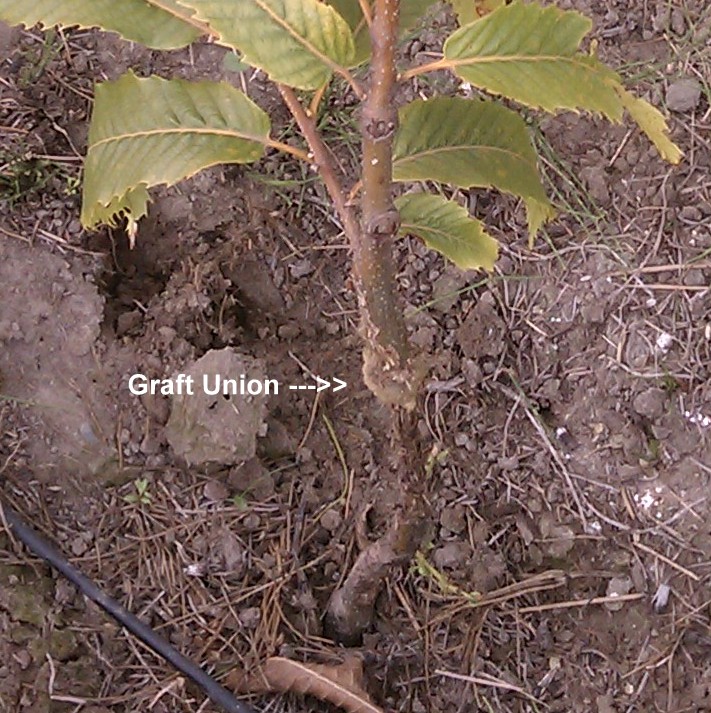
Dehydration is a problem for many living organisms, the such likes of plants,
animals, and people too. Dehydration starts with a simple "I am thirsty"
progressing through "Would someone just give me a drink of water", and without
intervention, dehydration can result in the death of the organism. Pictured
below is a chestnut tree saying, "Would someone give me some water, I feel like
I might die". The reality of the situation is the chestnut tree is suffering
from water stress induced by drought during the growing season. Chestnut trees
are drought resistant. The tree pictured here is a Colossal that will drop all
its burrs and some of its leaves because of the water stress. The tree went
dormant early without producing any nuts. Rains did come before the end of the
growing season providing the tree with enough water that the tree made
a full recovery next growing season.
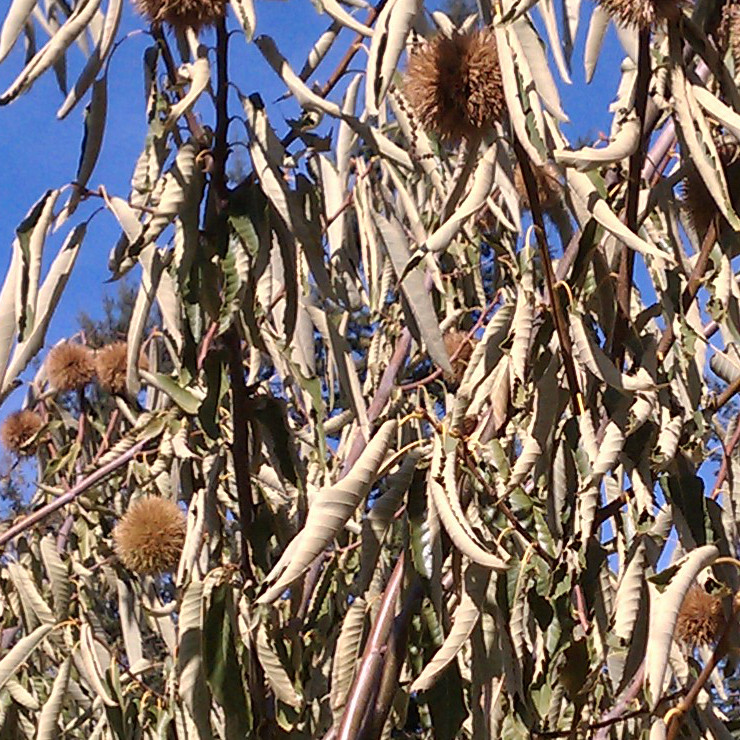
There are two important lessons presented here. The first lesson is that an
orchardist needs to take time to look over the trees in the orchard, observing
the leaves and looking for possible problems. The second lesson is keeping
history. When a patient arrives at the doc's office, the doc asks all kinds of
questions about what is happening, what happened in the recent past, and for
new patients the doc asks for a complete history.
When a problem is presented to the doc, the doc will often order some lab
tests. With chestnut trees our lab tests consist of leaf samples and soil
samples. The results of the lab test will likely provide enough information
to find a way to correct the presenting problem. If your chestnut tree orchard
is facing a problem then get the lab tests done, its worth the money and cuts
out a lot of guessing.
Taking time to walk through the orchard is a great stress reducer. Take the
walk often, express your thanks for at least one thing you can be thankful for
and your life will be a lot happier.
|
|
|
|
|







